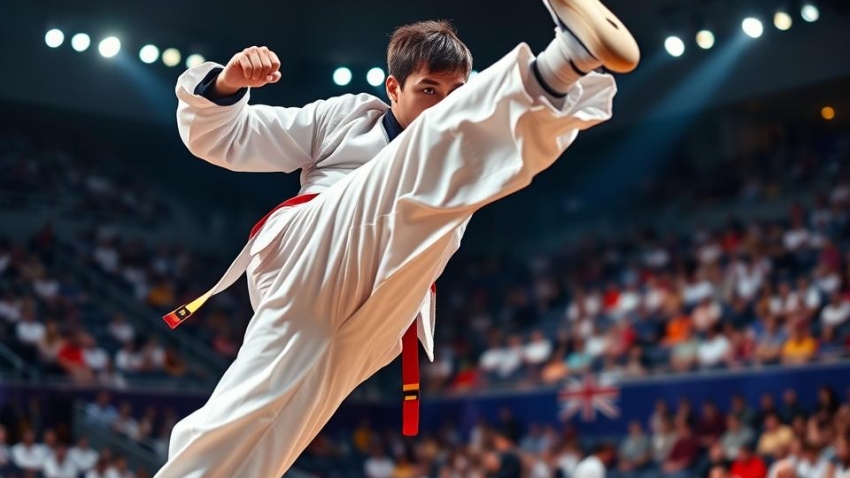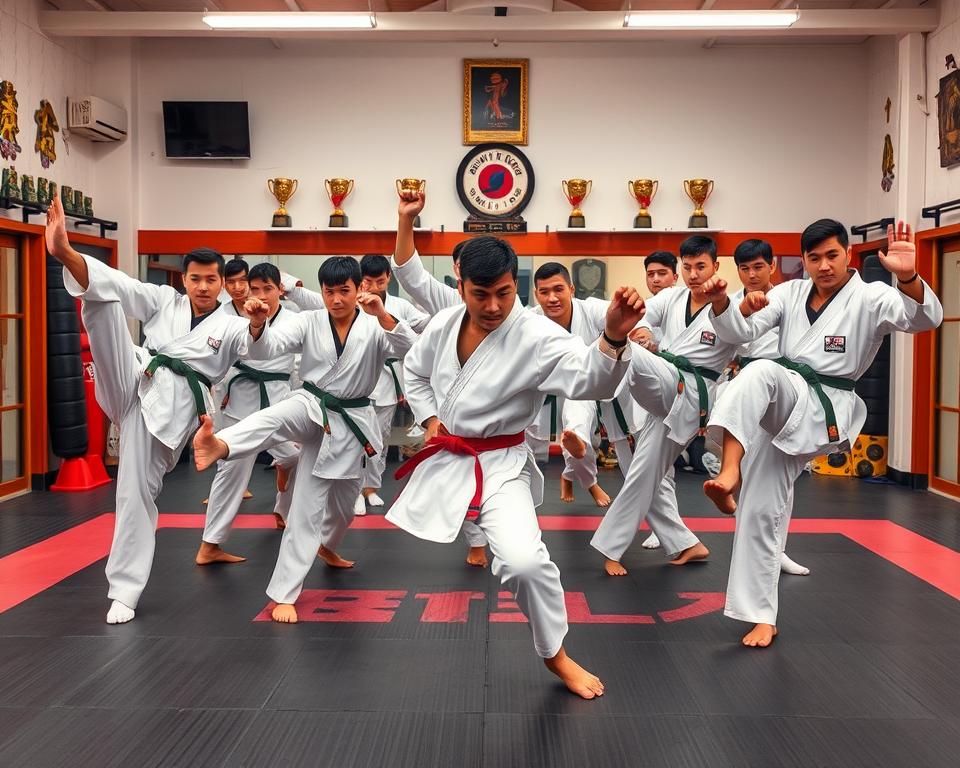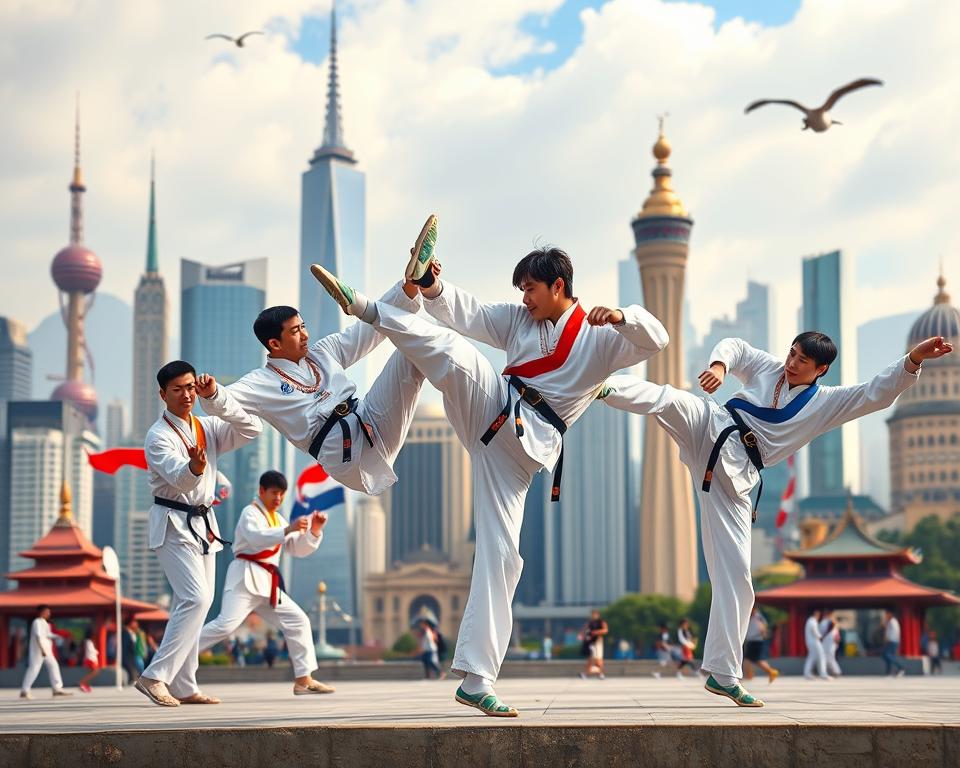
Sport Taekwondo: Olympic Martial Art Excellence
Taekwondo is a dynamic Korean martial art that has become a big part of the Olympics. It combines physical strength, strategy, and deep cultural roots. This guide will take you through the world of sport taekwondo. We’ll look at its history, key principles, competitive nature, and the benefits for people of all ages and skills.
Read interesting things at : revolutionbookscamb
Key Takeaways
- Taekwondo is a Korean martial art with a rich cultural heritage, dating back centuries.
- The sport of taekwondo emphasizes precise techniques, mental focus, and physical fitness.
- Taekwondo became an official Olympic sport in 2000, showcasing its global appeal.
- Practicing taekwondo can improve strength, flexibility, endurance, and self-defense skills.
- The sport’s emphasis on discipline, respect, and personal growth makes it a rewarding pursuit for individuals of all ages.
Exploring the Ancient Roots of Taekwondo
Taekwondo’s roots go way back to ancient Korea. There, martial arts were developed and improved over many centuries. This deep cultural history has greatly shaped the sport today, from its old techniques to its guiding principles.
Korea’s Cultural Heritage
The Korean peninsula has a rich history of martial arts, with combat systems dating back to the Three Kingdoms period (57 BC – 935 AD). Early martial arts like subak and taekkyon were more than just self-defense. They were key parts of the area’s lively culture.
The Evolution of Martial Arts
Over time, these ancient Korean martial arts changed and grew, taking in ideas from nearby areas and philosophies. The creation of taekkyeon and taekwondo shows how these arts evolved and innovated.
The deep thoughts behind these martial arts were key to how they were practiced. Values like courtesy, integrity, perseverance, self-control, and indomitable spirit formed the base of the mental and spiritual disciplines in taekwondo today.
“Taekwondo is not just a game of physical techniques, but a way of life that emphasizes the harmony of mind and body.”
| Traditional Korean Martial Arts | Influences and Developments |
|---|---|
| Subak | Early combat system dating back to the Three Kingdoms period |
| Taekkyon | Fluid and dynamic martial art that evolved over time |
| Taekwondo | Comprehensive system of striking and kicking techniques, incorporating various cultural influences |
Understanding the Principles of Sport Taekwondo
Sport taekwondo is built on key principles that guide its athletes. These principles come from Korea’s rich culture. They focus on precision, speed, power, and mental discipline. These are vital for doing well in this fast-paced martial art.
One main principle is disciplined training. Athletes work hard to improve their skills. They learn many combat strategies and technical moves. This hard work is key to mastering the martial arts principles of the sport.
Another important principle is self-defense and being aware of your surroundings. Taekwondo teaches athletes to use their strength and mind to protect themselves. They also learn to respect the art and its possible outcomes.
| Core Principles of Sport Taekwondo | Description |
|---|---|
| Precision | Focus on doing techniques correctly and accurately |
| Speed | Fast, sudden movements and quick reactions |
| Power | Creating a lot of force and impact with strikes and kicks |
| Mental Discipline | Building focus, concentration, and mental strength |
These key principles are the base of sport taekwondo. They help athletes do well in this exciting martial art.
“In taekwondo, the mind and body must work in perfect harmony to achieve true mastery of the art.”
The Olympic Journey of Taekwondo
Taekwondo’s journey to the Olympics is truly amazing. It started as an ancient Korean martial art and became a olympic martial arts discipline loved worldwide. The path to becoming an Olympic sport was filled with hard work, determination, and a love for sharing the art globally.
Becoming an Official Olympic Sport
Taekwondo first appeared at the 1988 Summer Games in Seoul, South Korea, as a demonstration sport. For the next ten years, its leaders worked hard to make it a full Olympic sport. This journey had many important steps, including:
- The official recognition of taekwondo as an international competitions sport by the International Olympic Committee in 1994.
- The inclusion of taekwondo in the Olympic program as a medal event at the 2000 Sydney Olympics, making it a permanent part of the Games.
- The continued growth and popularity of competitive taekwondo at the Olympics, drawing big audiences and exciting fans worldwide.
Now, taekwondo is a key part of the Olympics, showing off its mix of athleticism, skill, and cultural roots to people all over the world. This global recognition has made the sport more popular and helped grow olympic martial arts worldwide.
| Year | Event |
|---|---|
| 1988 | Taekwondo demonstrated as a sport at the Seoul Olympics |
| 1994 | Taekwondo recognized as an international sport by the IOC |
| 2000 | Taekwondo included as a medal event at the Sydney Olympics |
Adding taekwondo to the Olympics has boosted its popularity and inspired many young athletes to compete in competitive taekwondo at the highest level. This legacy keeps shaping the sport’s future, making it a cherished part of the Olympics.
Sport Taekwondo: A Disciplined Pursuit
Sport taekwondo is all about a deep commitment to discipline, both in body and mind. This ancient martial art requires a high level of effort and focus. It stands out from many other sports because of this.
At the core of sport taekwondo is a disciplined training routine. It challenges practitioners to their limits. Every move, from kicking to forms, is done with precision and respect. This focus not only improves physical skills but also builds mental strength and self-control.
It’s not just about the body. Sport taekwondo also values respect and etiquette. Students learn to respect the art’s traditions and its cultural roots. This mental focus helps them develop self-awareness, concentration, and emotional control. These are key for success in and out of the dojang.
Practicing sport taekwondo shows the power of physical fitness and mental discipline. By following the sport’s tough training and values, practitioners grow personally. They achieve more than they ever thought possible, both in and out of the dojang.
“Taekwondo is not just a sport; it’s a way of life. The discipline and focus it requires permeate every aspect of the practitioner’s existence.” – Master Kim, renowned taekwondo instructor
| Key Aspects of Sport Taekwondo | Description |
|---|---|
| Disciplined Training | The rigorous training regimen that hones physical abilities and mental focus. |
| Martial Arts Discipline | The emphasis on respect, etiquette, and upholding the traditions of the art. |
| Physical Fitness | The development of strength, flexibility, and endurance through consistent practice. |
| Mental Focus | The cultivation of self-control, concentration, and emotional awareness. |
Mastering the Art of Kicking
Taekwondo is a dynamic Korean martial art known for its amazing kicking skills. It’s a key part of the Olympic sport. These kicks require great athletic ability and combat skills.
Techniques and Forms
Practitioners of Taekwondo work hard to learn many kicking techniques. They master the quick front kick and the impressive spinning hook kick. Each kick needs perfect form, balance, and timing.
Learning to kick well in Taekwondo also means perfecting forms. These are set patterns of moves. Known as poomsae, they’re not just pretty to watch. They help build the skills needed to win in competitions.
| Kicking Technique | Description |
|---|---|
| Front Kick | A quick, straight kick directed at the opponent’s midsection or face. |
| Roundhouse Kick | A circular kick that strikes the opponent’s side or ribs. |
| Axe Kick | A vertical kick that descends like an axe, targeting the opponent’s head or shoulders. |
| Spinning Hook Kick | An acrobatic kick that involves a spinning motion and a hook-like strike to the opponent’s head or upper body. |
“Mastering the kicking techniques in Taekwondo is not just about physical prowess, but also about harnessing mental discipline and precision.”
The Physical and Mental Benefits of Taekwondo
Sport taekwondo brings many benefits for both the body and mind. It’s an ancient martial art that makes you stronger and mentally healthier. It helps with self-improvement and personal growth.
Cultivating Strength, Flexibility, and Endurance
Taekwondo’s kicking moves and hard training build muscle strength, flexibility, and endurance. Practicing regularly makes you lean and strong. It focuses on core strength, agility, and balance.
- Improved cardiovascular health and endurance
- Enhanced muscle tone and flexibility
- Increased coordination and body awareness
Taekwondo also boosts your mental health. The focus and discipline in training improve your self-control, concentration, and mental toughness.
| Physical Benefits | Mental Benefits |
|---|---|
| Muscular Strength | Improved Focus |
| Flexibility | Increased Discipline |
| Cardiovascular Endurance | Enhanced Mental Resilience |
Learning taekwondo means facing physical and mental challenges. This leads to feeling more accomplished and confident. It’s great for those wanting to get fitter, mentally healthier, and grow personally.

“Taekwondo is not just a physical art; it’s a mental and spiritual journey as well. The discipline and focus required on the mat translate to all aspects of life.”
The Competitive Spirit of Sport Taekwondo
At the core of sport taekwondo, a thrilling spirit of competition exists. Practitioners show off their skills and techniques in tournament competition. This martial art is known for intense rivalries, strategic thinking, and strong sportsmanship. Athletes aim for the top of athletic performance.
Taekwondo tournaments test both physical and mental strength. Fighters use kicks, blocks, and strikes to win. The quick moves and explosive moments make the matches exciting. They show the hard work and strong will of the athletes.
- Competitors must understand complex scoring and strategy to beat their opponents.
- Sportsmanship is key, with athletes showing respect and friendship, even when competing hard.
- The drive for excellence in competitive martial arts makes athletes improve their skills and fitness.
The spirit of sport taekwondo is more than just winning or losing. It shows the discipline, focus, and determination of this ancient Korean art. As athletes aim higher, they show the real spirit of the sport. They inspire others and athletes alike.
“In taekwondo, the true victory is not over the opponent, but over oneself.”
– Grand Master Hwang Kee
Competitive martial arts highlight the amazing athleticism and sportsmanship of taekwondo. The excitement of tournaments shows the power of this respected art.
Taekwondo and Self-Defense
Sport taekwondo focuses on the athletic side of the martial art. But, it also teaches important self-defense skills. These skills help people protect themselves in real life.
Practical Applications
Self-defense techniques in taekwondo are more than just about fighting. They help people stay safe in different situations. They teach how to stop threats and defend against attacks.
Taekwondo is great for learning practical skills that work in real life. Students learn to use kicks, footwork, and moves to protect themselves. This makes a strong self-defense system.
- Effective strikes and blocks to ward off attackers
- Rapid movement and agility to avoid dangerous situations
- Techniques to incapacitate and escape from assailants
- Situational awareness and conflict de-escalation strategies
Learning these skills gives taekwondo students confidence to protect themselves and others. The focus and discipline of taekwondo help develop self-defense skills for real life.
“Taekwondo is not just about kicking and punching; it’s about developing the mental and physical resilience to keep yourself safe.”
With regular practice, taekwondo students get better at being aware, in control, and making quick decisions. These skills are key for self-defense. This full approach to martial arts helps people handle dangerous situations with confidence.
Taekwondo’s Global Reach
Taekwondo has grown beyond its Korean roots to become a global martial art. It now reaches people across the world. The sport’s popularity and efforts to bring people together have helped spread cultural exchange and understanding.
Now, taekwondo is practiced in over 200 countries, making it a top international martial art. You can hear its sounds in New York and Africa. This sport unites people worldwide through their love for it.
The growth of taekwondo is thanks to groups like the World Taekwondo Federation. They work hard to spread the art and its values. Events like the World Taekwondo Championships and the Olympics help bring people together. These efforts have made the sport popular in many places, promoting cultural exchange and friendship.
| Region | Taekwondo Practitioners | Growth Rate (2015-2020) |
|---|---|---|
| Asia | 50 million | 15% |
| Europe | 10 million | 20% |
| Americas | 8 million | 18% |
| Africa | 3 million | 25% |
Taekwondo’s global impact shows how it can cross cultural lines and bring people together. As it grows, it remains a symbol of how international martial arts can help us understand and connect with each other. It encourages diverse participation in a global community.

“Taekwondo is not just a sport; it’s a way of life that connects people from all corners of the world. Through the universal language of martial arts, we can bridge cultural divides and create a more understanding and harmonious global community.”
Training and Etiquette in the Dojang
The dojang is the heart of taekwondo, where its ancient spirit thrives. It’s a place where respect, discipline, and Korean traditions shape a practitioner’s journey. These values are the core of taekwondo.
Respecting the Traditions
Walking into the dojang is a sign of respect and commitment to the martial arts training ahead. Students must follow dojo etiquette. This means bowing when entering or leaving, showing respect to instructors, and keeping a disciplined practice during sessions.
The Korean traditions that shape taekwondo are central in the dojang. From the uniforms and belts that show rank to the rituals during training, every detail honors the art’s heritage.
“The dojang is not just a place to train; it is a sanctuary where the principles of taekwondo are upheld and passed down from generation to generation.”
Practitioners who respect the dojang’s ways develop deep respect and commitment to taekwondo. This approach improves their skills and helps them understand the art’s cultural and historical depth.
| Dojang Etiquette | Importance |
|---|---|
| Proper bowing upon entering and exiting | Shows respect for the training space and instructors |
| Addressing instructors with honorifics | Demonstrates respect for authority and seniority |
| Maintaining a disciplined practice | Reinforces the values of focus, dedication, and self-control |
| Wearing traditional uniforms and belts | Honors the art’s heritage and symbolizes rank and experience |
Taekwondo for All Ages and Levels
Taekwondo is a dynamic martial art that welcomes people of all ages and backgrounds. It’s a sport that offers many benefits, making it great for everyone, no matter their skill level.
It doesn’t matter if you’re just starting or have been doing it for years. Taekwondo has something for you. Kids can work on their agility and strength. Seniors can improve their balance and flexibility. It meets the needs of each person.
- Inclusive martial arts for all ages and abilities
- Diverse participants find satisfaction in Taekwondo
- Lifelong practice promotes personal growth and well-being
- Accessible training tailored to individual needs and goals
Taekwondo brings people together, creating a strong sense of community. This helps everyone, no matter their age or skill, grow and learn together. It’s a journey that changes lives, offering both mental and physical benefits.
| Age Group | Taekwondo Benefits |
|---|---|
| Children | Improved coordination, discipline, and self-confidence |
| Teens | Enhanced physical fitness, focus, and life skills |
| Adults | Stress relief, weight management, and personal empowerment |
| Seniors | Better balance, flexibility, and overall well-being |
Taekwondo is for everyone, at every stage of life. It’s a journey of growth and development. Whether you’re new or experienced, Taekwondo offers a unique experience. It welcomes everyone to join and enjoy this exciting martial art.
“Taekwondo is not just a physical activity; it’s a journey of self-discovery that transcends age and skill level.”
The Future of Sport Taekwondo
The future of taekwondo is bright, with new innovations and advancements coming soon. Smart uniforms and new scoring systems will change how we practice and compete. These tools will make watching the sport better and help athletes train and perform better.
Technological progress is just one part of the story. Taekwondo is also growing worldwide. More people from different places are joining, bringing new ideas and values. This growth means more people will learn and share the values of taekwondo.
Looking to the future, taekwondo will keep getting better with new ideas and more people joining. It will become more accessible and connect more with other sports. As it grows, taekwondo will continue to inspire and captivate people around the world. It will stay a top Olympic sport and a symbol of martial arts’ future.









Leave a Reply